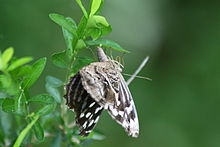Adelia
| Adelia | |
|---|---|

| |
| with ovipositing Myscelia ethusa | |
| Scientific classification | |
| Kingdom: | Plantae |
| Clade: | Tracheophytes |
| Clade: | Angiosperms |
| Clade: | Eudicots |
| Clade: | Rosids |
| Order: | Malpighiales |
| Family: | Euphorbiaceae |
| Subfamily: | Acalyphoideae |
| Tribe: | Adelieae |
| Genus: | Adelia L. 1759, conserved name, not P.Browne 1756 (Oleaceae) |
| Synonyms[1][2] | |
|
Ricinella Müll.Arg. | |
Adelia is a genus of flowering plants in the spurge family, Euphorbiaceae, subfamily Acalyphoideae.[1] It is native to Latin America and the Caribbean, with one species extending northward into the southernmost part of Texas.[2][3][4][5][6][7]
The name is derived from the Greek words α (a), meaning "not", and δήλος (delos), meaning "visible." It refers to the difficulties Linnaeus experienced interpreting the genus.[8]
Species[]
- Current species include
- [2]
- Adelia barbinervis Cham. & Schltdl. – hairynerve adelia - Mexico, N Central America
- V.W.Steinm. - Baja California Sur, Sonora
- (Wiggins & Robbins) A.Cerv., V.W.Steinm. & Flores-Olvera - Sonora
- (Müll.Arg.) Chodat & Hassl. - Brazil, Bolivia, Paraguay, NE Argentina
- (Müll.Arg.) Hemsl. – Oaxaca Adelia - most of Mexico from San Luis Potosí + Sinaloa to Chiapas + Quintana Roo
- Wiggins & Robbins - Sonora, Sinaloa
- Pax & K.Hoffm. - Panama
- L. – Wild Lime - West Indies, Venezuela, Colombia
- (Müll.Arg.) Hemsl. – threelobe adelia - Central America, Colombia, Ecuador, Venezuela
- (Coult.) Pax & K.Hoffmann – Vasey's wild lime - Tamaulipas, S Texas (Starr, Hidalgo, Cameron, + Willacy Counties)[9][10][11][12]
- Formerly included species (including in Oleaceae homonym) moved to other genera, including
- (Alchornea, Bernardia, Doryxylon, Erythrococca, Flueggea, Forestiera (Oleaceae), Garciadelia, Homonoia, Lasiocroton, Macaranga, Mallotus, and Spathiostemon )
- A. acidoton L. 1759 not Blanco 1837 -
- A. acidoton Blanco 1837 not L. 1759 - Doryxylon spinosum
- A. acuminata - Forestiera acuminata
- A. angustifolia -
- A. anomala -
- A. barbata - Mallotus mollissimus
- A. bernardia Blanco 1837 not L. 1759 - Mallotus mollissimus
- A. bernardia L. 1759 not Blanco 1837-
- A. caperoniifolia -
- A. cassinoides - Forestiera segregata
- A. castanocarpa - Chaetocarpus castanocarpus
- A. celastrinea -
- A. cordifolia -
- A. cuneata -
- A. dodecandra -
- A. ferruginea -
- A. glandulosa -
- A. globularis - Forestiera segregata
- A. gracilis -
- A. hirsutissima -
- A. houlletiana - subsp. houlletiana
- A. javanica - Spathiostemon javensis
- A. leprosa -
- A. ligustrina - Forestiera ligustrina
- A. martii -
- A. microphylla -
- A. monoica - Melanolepis multiglandulosa
- A. neomexicana - Forestiera pubescens var. parvifolia
- A. neriifolia - Homonoia riparia
- A. ovata - Forestiera acuminata
- A. papillaris -
- A. parvifolia - Forestiera pubescens
- A. phillyreoides -
- A. pinetorum - Forestiera segregata var. pinetorum
- A. porulosa - Forestiera segregata
- A. pubescens - Forestiera pubescens
- A. pulchella -
- A. resinosa - Mallotus resinosus
- A. reticulata -
- A. retusa -
- A. rhamnifolia -
- A. rotundifolia -
- A. scabrida - subsp. scabrida
- A. segregata - Forestiera segregata
- A. spartioides -
- A. sphaerocarpa - Forestiera pubescens var. parvifolia
- A. tamanduana -
- A. tenuifolia -
- A. virgata Poir. 1810 not Brandegee 1894 - Flueggea tinctoria
References[]
- ^ a b "Genus: Adelia L." Germplasm Resources Information Network. United States Department of Agriculture. 2007-10-12. Archived from the original on 2011-06-05. Retrieved 2010-04-09.
- ^ a b c Kew World Checklist of Selected Plant Families
- ^ De-Nova, J.A.; Sosa, V.; Steinmann, V.W. (2007). "A synopsis of Adelia (Euphorbiaceae s.s.)". Systematic Botany. 32: 583–595. doi:10.1600/036364407782250535.
- ^ Martínez Gordillo, M.; Ramírez, J. J.; Durán, R. C.; Arriaga, E. J.; García, R.; Cervantes, A.; Hernández, R. M. (2002). "Los géneros de la familia Euphorbiaceae en México". Anales del Instituto de Biología de la Universidad Nacional Autónoma de México, Botánica. 73 (2): 155–281.
- ^ Stevens, W. D., C. Ulloa Ulloa, A. Pool & O. M. Montiel. 2001. Flora de Nicaragua. Monographs in systematic botany from the Missouri Botanical Garden 85: i–xlii,.
- ^ Forzza, R. C. 2010. Lista de espécies Flora do Brasil "Archived copy". Archived from the original on 2015-09-06. Retrieved 2015-08-20.CS1 maint: archived copy as title (link). Jardim Botânico do Rio de Janeiro, Rio de Janeiro
- ^ González Ramírez, J. 2010. Euphorbiaceae. En: Manual de Plantas de Costa Rica. Vol. 5. B.E. Hammel, M.H. Grayum, C. Herrera & N. Zamora (eds.). Monographs in systematic botany from the Missouri Botanical Garden 119: 290–394
- ^ Jestrow, Brett (2010). "Introduction". Phylogenetics, Conservation, and Historical Biogeography of the West Indian Members of the Adelieae (Euphorbiaceae) (Ph.D. thesis). Florida International University. Retrieved 2011-08-08.
- ^ "Adelia". Integrated Taxonomic Information System. Retrieved 2010-04-09.
- ^ De-Nova, Jose Arturo; Victoria Sosa; Kenneth J. Wurdack (2006). "Phylogenetic Relationships and the Description of a New Species of Enriquebeltrania (Euphorbiaceae s.s.): An Enigmatic Genus Endemic to Mexico" (PDF). Systematic Botany. 31 (3): 77–111. doi:10.1600/036364406778388719. JSTOR 25064183. Archived from the original (PDF) on 2011-08-10.
- ^ Grandtner, Miroslav M. (2005). Elsevier's Dictionary of Trees: With Names in Latin, English, French, Spanish and Other Languages. 1. Elsevier. p. 28. ISBN 978-0-444-51784-5.
- ^ Biota of North America Program 2013 county distribution map, Adelia vaseyi
External links[]
| Wikispecies has information related to Adelia. |
| Wikimedia Commons has media related to Adelia (Euphorbiaceae). |
Categories:
- Adelieae
- Euphorbiaceae genera
- Flora of the Caribbean
- Flora of Central America
- Flora of North America
- Flora of South America
- Taxa named by Carl Linnaeus
- Euphorbiaceae stubs